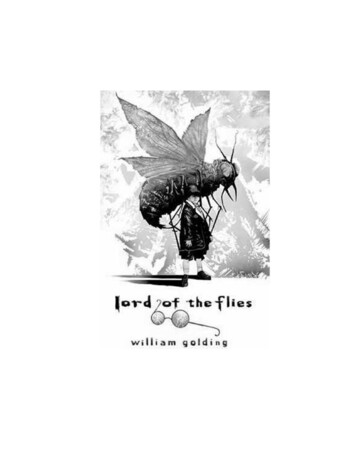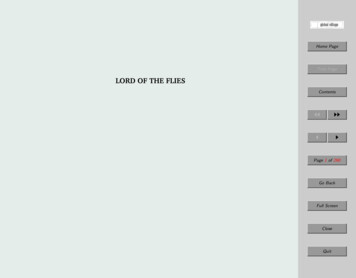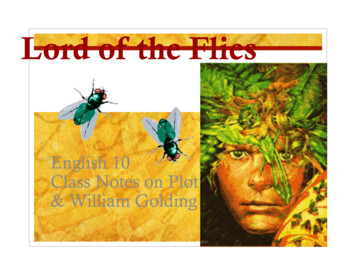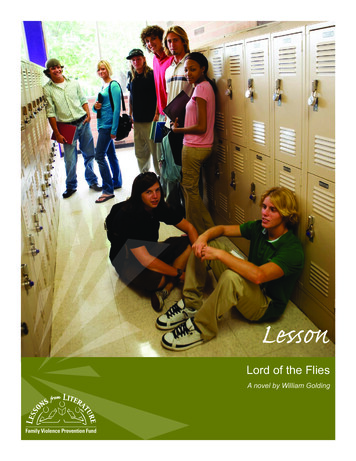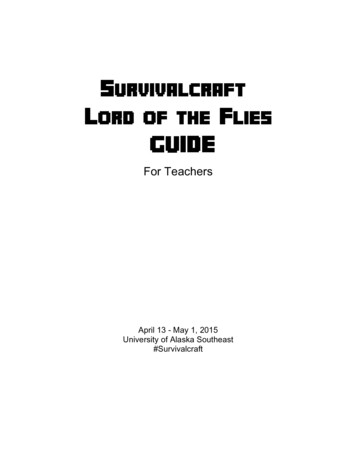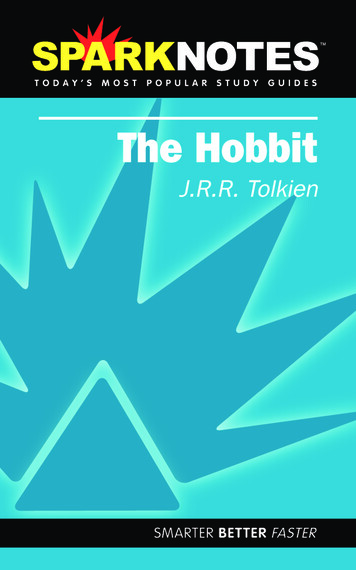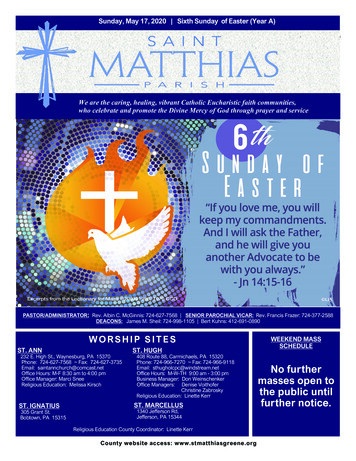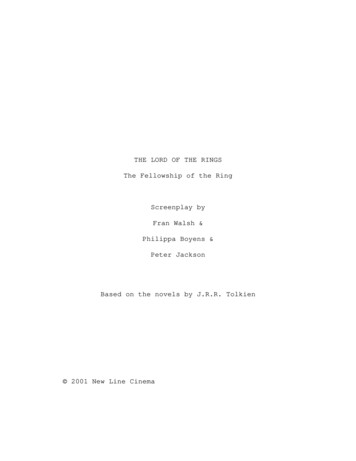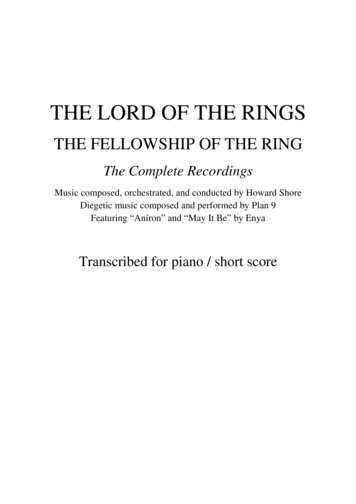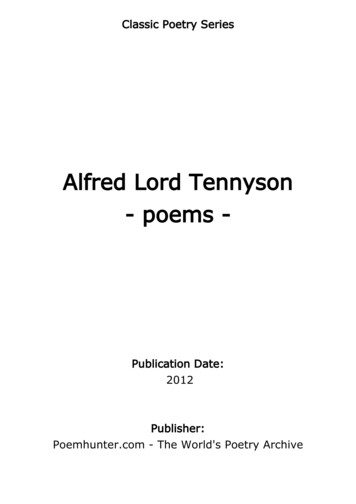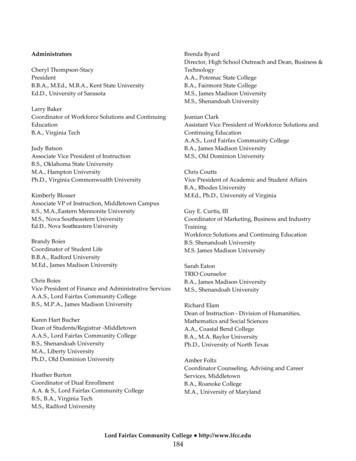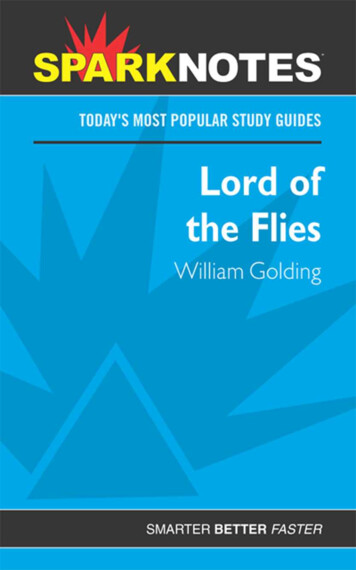
Transcription
LORD OFTHE FLIESWilliam Golding
Contributors: Brian Phillips, Ellen Feldman, Jeremy ZornCopyright 2002 by SparkNotes LLCAll rights reserved. No part of this book may be used or reproduced inany manner whatsoever without the written permission of the Publisher.SPARKNOTES is a registered trademark of SparkNotes LLC.This edition published by Spark PublishingSpark PublishingA Division of SparkNotes LLC76 9th Avenue, 11th FloorNew York, NY 10011ISBN 1-4014-0393-XText design by Rhea BraunsteinText composition by Jackson TypesettingPrinted and bound in the United States of America01 02 03 04 05 SN 9 8 7 6 5 4 3 2 1RRD-Cwww.sparknotes.com
INTRODUCTIONSTOPPINGTOBUY SPARKNOTESON ASNOWY EVENINGWhose words these are you think you know.Your paper’s due tomorrow, though;We’re glad to see you stopping hereTo get some help before you go.Lost your course? You’ll find it here.Face tests and essays without fear.Between the words, good grades at stake:Get great results throughout the year.Once school bells caused your heart to quakeAs teachers circled each mistake.Use SparkNotes and no longer weep,Ace every single test you take.Yes, books are lovely, dark, and deep,But only what you grasp you keep,With hours to go before you sleep,With hours to go before you sleep.
CONTENTSCONTEXT1PLOT OVERVIEW3CHARACTER LIST6ANALYSIS OF MAJOR CHARACTERS8Ralph8Jack9Simon9THEMES, MOTIFS, AND SYMBOLS11Civilization and Savagery11Loss of Innocence12Christian Iconography12The Conch Shell13Piggy’s Glasses14The Signal Fire14The Beast14The Lord of the Flies15Ralph, Piggy, Jack, Simon, Roger15SUMMARY AND ANALYSIS16Chapter 116Chapter 218Chapter 321
vi ContentsChapter 423Chapter 526Chapter 628Chapter 730Chapter 832Chapter 936Chapter 1038Chapter 1140Chapter 1242IMPORTANT QUOTATIONS EXPLAINED45KEY FACTS48STUDY QUESTIONS AND ESSAY TOPICS50REVIEW AND RESOURCES53Quiz53Suggestions for Further Reading58
CONTEXTWilliam Golding was born on September 19, 1911, in Cornwall, England. After graduating from Oxford, he workedbriefly as an actor, then became a schoolteacher. When England entered World War II, Golding joined the Royal Navy. After the war,he resumed teaching and also began writing novels. His first and greatest success came with 1954’s Lord of the Flies, after which he was able toretire from teaching and devote himself fully to writing. Although henever again attained the kind of popular and artistic success he enjoyedwith Lord of the Flies, on the basis of that book he remained a respectedand distinguished author for the rest of his life, publishing several novelsand a play, The Brass Butterfly (1958). He was awarded the Nobel Prizefor Literature in 1983. William Golding died in 1993, one of the mostacclaimed writers in England.Lord of the Flies, which tells the story of a group of English boysmarooned on a tropical island after their plane is shot down duringa war, is fiction. But the book’s exploration of the idea of human evilis to some extent based on Golding’s experience with the violenceand savagery of human beings during World War II. In exploring thebreakdown into savagery of a group of boys free from the imposedmoral constraints of civilization and society, Lord of the Flies dramatizes a fundamental human struggle: the conflict between the impulseto obey rules, behave morally, and act lawfully and the impulse to seekbrute power over others, act selfishly, behave in a way that will gratifyone’s own desires, scorn moral rules, and indulge in violence. The firstset of impulses might be thought of as the “civilizing instinct,” whichencourages people to work together toward common goals and behavepeacefully; the second set of impulses might be thought of as the “barbarizing instinct,” or the instinct toward savagery, which urges peopleto rebel against civilization and instead seek anarchy, chaos, despotism,and violence. The novel’s structure and style are extremely straightforward. The book largely excludes poetic language, lengthy description,and philosophical interludes. The novel is also allegorical, meaning that
2 Lord of the Fliescharacters and objects in the book directly represent the novel’s centralthematic ideas.Because its story is allegorical, Lord of the Flies can be interpretedin many ways. During the 1950s and 1960s, many readings of the bookconnected it with grand historical, religious, and psychological schemes:the book was said to have dramatized the history of civilization, thehistory of religion, or the struggle among the Freudian components ofunconscious identity—id, ego, and superego. Since the book does dealwith fundamental human tendencies, there is a glimmer of truth ineach of these readings, but it is important to remember that the novel’sphilosophical register is really quite limited—almost entirely restrictedto the two extremes represented by Ralph and Jack—and is certainly notcomplex or subtle enough to offer a realistic parallel to the history ofhuman endeavors as a whole. Every element of Lord of the Flies becomesmeaningful in relation to the book’s exploration of its particular philosophical conflict.
PLOT OVERVIEWIn the midst of a raging war, a plane evacuating a group of Englishboys from Britain is shot down over a deserted tropical island.Marooned, the boys set about electing a leader and finding a wayto be rescued. They choose Ralph as their leader, and Ralph appointsJack to be the leader of the hunters. Ralph, Jack, and Simon set off onan expedition to explore the island. When they return, Ralph declaresthat they must light a signal fire to attract the attention of passing ships.The boys begin to do so, using the lens from Piggy’s eyeglasses to ignitedead wood, but they are more interested in playing than in paying closeattention to their duties, and the fire quickly ignites the forest. A largeswath of dead wood burns out of control. One of the youngest boys disappears, presumably having burned to death.At first, the boys enjoy their life without grown-ups. They splash inthe lagoon and play games, though Ralph complains that they shouldbe maintaining the signal fire and building huts for shelter. The huntershave trouble catching a pig, but Jack becomes increasingly preoccupiedwith the act of hunting. One day, a ship passes by on the horizon, andRalph and Piggy notice, to their horror, that the signal fire has burnedout; it had been the hunters’ responsibility to maintain it. Furious,Ralph accosts Jack, but the hunter has just returned with his first kill,and all the boys seem gripped with a strange frenzy, reenacting thechase in a kind of wild dance. When Piggy criticizes him, Jack hits himacross the face.Ralph blows the conch shell used to summon the boys and reprimands them in a speech intended to restore order. Yet there is a larger,more insidious problem than keeping the signal fire lit and overcoming the difficulties of hunting: the boys have started to become afraid.The littlest boys (known as “littluns”) have been troubled by nightmares from the beginning, and more and more boys now believe thatthere is some sort of beast or monster lurking on the island. At themeeting, the older boys try to convince the others to think rationally:if there were a monster, where would it hide during the daytime? One
4 Lord of the Fliesof the littluns suggests that it hides in the sea, a proposition that terrifies the whole group.Not long after the meeting, an aircraft battle takes place high abovethe island. The boys are sleeping, so they do not notice the flashinglights and explosions in the clouds. A parachutist drifts to earth on thesignal fire mountain. He is dead. Sam and Eric, the twins responsiblefor watching the fire at night, have fallen asleep, so they do not see himland. But when they wake up, they see the enormous silhouette of hisparachute and hear the strange flapping noises it makes. Thinking thebeast is at hand, they rush back to the camp in terror and report that thebeast has attacked them.The boys organize a hunting expedition to search for monsters. Jackand Ralph, who are increasingly at odds, travel up the mountain. Theysee the silhouette of the parachute from a distance and think that it lookslike a huge, deformed ape. The group holds a meeting, at which Jack andRalph tell the others of the sighting. Jack says that Ralph is a coward andthat he should be removed from office, but the other boys refuse to votehim out of power. Jack angrily runs away down the beach, calling all thehunters to join him. Ralph rallies the remaining boys to build a new signal fire, this time on the beach instead of on the “monster’s” mountain.They obey, but before they have finished the task, most of them haveslipped away to join Jack.Jack declares himself the leader of this new tribe, and organizes ahunt and violent, ritual slaughter of a sow to solemnize the occasion.They then decapitate the sow and place its head on a sharpened stake inthe jungle as an offering to the beast. Encountering the bloody, fly-covered head, Simon has a terrible vision, during which it seems to him thatthe head is speaking. The voice, which he imagines to belong to the Lordof the Flies, says that Simon will never escape him, for he exists within allmen. Simon faints; when he wakes up, he goes to the mountain, wherehe sees the dead parachutist. Understanding then that the monster doesnot exist externally but rather within each individual boy, Simon travelsto the beach to tell the others what he has seen. But they are in the midstof a chaotic revelry—even Ralph and Piggy have joined Jack’s feast—and when they see Simon’s shadowy figure emerge from the jungle, theyfall upon him and kill him with their bare hands and teeth.The following morning, Ralph and Piggy discuss what they have
Plot Overview 5done. Jack’s hunters attack them and their few followers, stealing Piggy’sglasses in the process. Ralph’s group travels to Jack’s stronghold, calledCastle Rock, in an attempt to make Jack see reason. But Jack ordersSam and Eric tied up and fights with Ralph. In the ensuing battle, oneboy, Roger, rolls a boulder down from the mountain, killing Piggy andshattering the conch shell. Ralph barely manages to escape a torrent ofspears.All night and throughout the following day, Ralph hides and ishunted like an animal. Jack has the other boys ignite the forest in orderto smoke him out of his hiding place. Ralph discovers and destroysthe sow’s head in the forest; eventually, however, he is forced out ontothe beach, where he knows the other boys will soon arrive to kill him.Ralph collapses in exhaustion, but when he looks up, he sees a Britishnaval officer standing over him. His ship noticed the blazing fire nowraging in the jungle. The other boys reach the beach and stop in theirtracks at the sight of the officer. Amazed at the spectacle of this groupof bloodthirsty, savage children, the officer asks Ralph to explain. Ralphis overwhelmed by the knowledge that he is saved, but thinking aboutwhat has happened on the island, he begins to weep. The other boysbegin to sob as well. The officer turns his back so that the boys mayregain their composure.
CHARACTER LISTRalph —The novel’s protagonist, a twelve-year-old English boy.Marooned on a tropical island with a group of boys when their transportplane is shot down, Ralph is elected leader of the group and attempts tocoordinate efforts to build a miniature civilization on the island. Ralphrepresents the civilizing instinct within human beings, as opposed to thesavage instinct symbolized by Jack.Jack —The novel’s antagonist, one of the older boys stranded on thejungle island. On the island, Jack is the leader of the hunters, but helongs for total power and becomes increasingly wild, barbarous, andcruel as the novel progresses. He is also adept at manipulating the otherboys. Jack represents the instinct of savagery within human beings, asopposed to the civilizing instinct represented by Ralph.Simon —Simon is in some ways the only naturally “good” character onthe island. He behaves kindly toward the younger boys and is willing towork for the good of their community. Moreover, because his motivation seems rooted in his deep feeling of connectedness to nature, Simonis the only character whose sense of morality does not seem to havebeen imposed by society. Simon represents a kind of natural goodness,as opposed to the unbridled evil of Jack and the imposed morality ofcivilization represented by Ralph and Piggy.Piggy—Ralph’s lieutenant. A whiny, intellectual boy, Piggy’s inventiveness frequently leads to innovation, such as the makeshift sundial, whichthe boys use to tell time. Piggy represents the scientific, rational side ofcivilization.Roger —Jack’s lieutenant. A sadistic, cruel older boy who brutalizes thelittluns and eventually murders Piggy by rolling a boulder onto him.
Character List 7Sam and Eric —A pair of twins closely allied with Ralph, Sam and Ericare always together and are often treated as a single entity by the otherboys; they are frequently referred to as “Samneric.” They are young andeasily excitable, and are subject to manipulation and coercion by Jackand his cronies.The Lord of the Flies —The name given to the sow’s head impaled ona stake and erected in the forest as an offering to the “beast” after Jack’smost brutal hunt. It comes to symbolize the primordial instincts ofpower and cruelty that take control of Jack’s tribe.
ANALYSIS OF MAJOR CHARACTERSRALPHRalph, a twelve-year-old boy marooned with a group of other boys ona deserted island, is the athletic, charismatic protagonist of Lord of theFlies. Elected the leader of the boys at the beginning of the novel, Ralphis the primary representative of order, civilization, and productive leadership in the novel. While most of the other boys are concerned withplaying, having fun, and avoiding work at the beginning of the novel,Ralph sets about building huts and thinking of ways to maximize theirchances of being rescued. For this reason, Ralph’s power and influenceover the other boys are extremely secure at the beginning of the novel.However, as the book progresses and the group succumbs to savageinstincts, Ralph’s position declines precipitously as Jack’s station rises.Eventually, all the boys except Piggy leave Ralph’s group for Jack’s, andRalph is left alone to be hunted by Jack’s tribe. Ralph never seriouslyconsiders joining Jack’s tribe in order to save himself.Ralph’s commitment to civilization and morality is very strong, andhis main wish is to be rescued and returned to the society of adults. In asense, this strength gives Ralph a moral victory at the end of the novel,when he casts the Lord of the Flies to the ground and takes up the stakeit is impaled on to defend himself against Jack’s hunters. Ralph understands, as Simon did, that savagery exists within all the boys, but he isdetermined not to let it overwhelm him.For much of the novel, Ralph is simply unable to understand whythe other boys would give in to base instincts of bloodlust and barbarism. The sight of the hunters chanting and dancing is baffling anddistasteful to him. But when Ralph hunts a boar for the first time, heexperiences the exhilaration and thrill of bloodlust and violence, andwhen he attends Jack’s feast, he is swept away by the frenzy, dancing onthe edge of the group and participating in the killing of Simon. Thisfirsthand knowledge of the evil that exists within him, as within allhuman beings, is tragic for Ralph, and it plunges him into listless despair
Analysis of Major Characters 9for several chapters. But this knowledge also enables him to cast downthe Lord of the Flies at the end of the novel. Ralph’s story ends semitragically; although he is rescued and returned to civilization, when hesees the naval officer, he weeps with the burden of his knowledge abouthumanity.JACKJack, the strong-willed, egomaniacal boy who is the novel’s prime representative of the instinct of savagery, violence, and power, is the antithesisof Ralph. From the beginning of the novel, Jack desires power aboveall other things; he is furious when he loses the election to Ralph andcontinually pushes the boundaries of his subordinate role in the group.Early on, Jack retains the sense of moral propriety and behavior that wasinstilled in him by society—he was the leader of the choirboys, after all.The first time he encounters a pig, he is unable to kill it. But Jack soonbecomes obsessed with hunting and devotes himself to the task, painting his face like a barbarian and giving himself over to bloodlust. Themore savage Jack becomes, the more he is able to control the rest of thegroup, which, apart from Ralph, Simon, and Piggy, largely follows himin casting off moral restraint and embracing violence and savagery. Bythe end of the novel, Jack has learned to use the boys’ fear of the beastto control their behavior, giving Golding a chance to explore how religion and superstition can be used as instruments of power. Jack’s love ofauthority and violence are intimately connected, as each enables him tofeel powerful and exalted.SIMONIf Ralph stands at one end of a line, representing civilization, and Jackstands at the other end of the line, representing savagery, where doesSimon stand? The answer is that, unlike all the other boys, Simon is noton the line at all; he stands on a different plane from every other character in the novel. Simon seems to represent a kind of innate, spiritualhuman goodness that is deeply connected with nature and, in its ownway, as primal as Jack’s evilness. The other characters in the novel abandon moral behavior as soon as civilization no longer imposes it upon
10 Lord of the Fliesthem; they are not innately moral but have simply been conditioned toact morally by the adult world, by the threat of punishment for misdeeds. To an extent, even the civility of Ralph and Piggy is a product ofsocial conditioning, as can be seen in their participation in hunt-dance.In the psychology of the novel, the civilizing impulse is not as deeplyrooted in the human psyche as the savage impulse. Alone of all the children on the island, Simon acts morally not out of some guilt or shamebut because he believes in its inherent value. He behaves kindly towardthe younger children, and he is the first to realize the problem posedby the beast and the Lord of the Flies—that is, that the monster on theisland is not some physical beast, but rather a savagery that lurks withineach human being. This idea finds representation in the sow’s head andeventually stands as the moral conclusion of the novel. The main problem of the book is the idea of inherent human evil. Against this, Simonseems to represent an idea of essential human goodness. Yet his brutalmurder by the other boys indicates the scarcity of that goodness amid anoverwhelming abundance of evil.
THEMES, MOTIFS, AND SYMBOLSTHEMESThemes are the fundamental and often universal ideas explored in a literary work.Civilization and SavageryThe overriding theme of the novel is the conflict between two competingimpulses that exist within all human beings: the instinct to live by rules,act peacefully, follow moral commands, and value the good of the groupon the one hand; and the instinct to gratify one’s immediate desires, actviolently to obtain supremacy over others, and enforce one’s will on theother. These two instincts may be called “the instinct of civilization”and “the instinct of savagery,” as one is devoted to values that promoteordered society and the other is devoted to values that threaten orderedsociety. The conflict might also be expressed as order vs. chaos, reasonvs. impulse, law vs. anarchy, or in any number of other ways, includingthe more generalized good vs. evil. Throughout the novel, the instinct ofcivilization is associated with goodness, while the instinct of savagery isassociated with evil.The conflict between the two instincts is the driving force of thenovel, explored through the dissolution of the young English boys’ civilized, moral, disciplined behavior as they accustom themselves to a wild,brutal, barbaric life as savages in the jungle. Lord of the Flies is an allegorical novel, which means that its main ideas and themes are frequentlyrepresented by symbols. Appropriately, the conflict between civilizationand savagery is represented most directly by the novel’s two main characters: Ralph, the protagonist, represents order and leadership, whileJack, the antagonist, represents savagery and the desire for power.In the novel’s presentation of human psychology, different peopleexperience the instincts of civilization and savagery to different degrees.Piggy, for instance, has no savage feelings, while Roger seems barelycapable of comprehending the rules of civilization. But, generally, the
12 Lord of the Fliesnovel portrays the instinct of savagery as far more primal and fundamental to the human psyche than the instinct of civilization. Moralbehavior, in Golding’s view, is often merely a forced imposition of civilization, rather than a natural expression of human individuality. Whenleft to their own devices, the novel seems to argue, people will becomecruel, wild, and barbaric. This idea of innate human evil is central toLord of the Flies, and finds expression in several important symbols,most notably the beast and the Lord of the Flies. Only Simon seems topossess anything like a natural, unforced goodness.Loss of InnocenceAs the boys on the island progress from well-behaved, orderly childrenwho hope to be rescued to cruel, bloodthirsty hunters who have nodesire to return to civilization, they naturally lose the sense of innocencethat they possessed at the beginning of the novel. The painted savages inChapter 12 who have hunted, tortured, and killed animals and humanbeings are a far cry from the simple children swimming in the lagoon inChapter 3. But Golding does not portray this loss of innocence as something that is done to the children; rather, it results naturally from theirincreasing contact with the innate evil and savagery within themselves.Civilization, in other words, can mitigate but never wipe out the innateevil that exists within all human beings. The loss-of innocence-themeis represented symbolically by the forest glade in which Simon sits inChapter 3: at first, it is a place of natural beauty and peace. But whenSimon returns later in the novel, he discovers the bloody sow’s headimpaled upon a stake in the middle of the clearing. The paradise hasbeen disrupted by the bloody offering to the beast, a powerful symbol ofinnate human evil disrupting childhood innocence.MOTIFSMotifs are recurring structures, contrasts, or literary devices that can helpto develop and inform the text’s major themes.Christian IconographyLord of the Flies is often described as a retelling of Christian parables.While that may be an oversimplification, the book does echo certain
Themes, Motifs, and Symbols 13Christian images and themes. Christian iconography is not explicit oreven directly symbolized in the novel; instead, it functions as a kind ofsubtle motif in the novel, adding thematic resonance to the main ideasof the story. The island itself, particularly Simon’s glade, functions as akind of Garden of Eden that is gradually corrupted by the introductionof evil. The Lord of the Flies may be seen as a symbol for the devil, sinceit works to promote evil among mankind. Further, because Simon is thecharacter who arrives at the moral truth of the novel, and because he iskilled sacrificially as a consequence of having discovered this truth, hislife has certain strong parallels with that of Jesus Christ. His conversation with the Lord of the Flies also parallels the confrontation betweenChrist and the devil in Christian theology.However, it is important to remember that the parallels betweenSimon and Christ are not complete, and to read the novel as a pureChristian allegory would overstate the case and thereby reduce therange of possible readings. For one thing, Simon lacks the supernaturalconnection to the divine that is the main characteristic of Jesus. Simonis wise in many ways, but he is not the son of God, and his death doesnot bring salvation to the island. Rather, his death plunges the islanddeeper into savagery and moral guilt. For another, Simon dies before heis able to tell the boys what he has discovered, while Christ was killedonly after spreading his moral philosophy. In this way, Simon (and thenovel as a whole) echoes Christian ideas and themes without developing precise parallels with them. Because Lord of the Flies uses its religious motifs to enhance its moral theme, Christian iconography is anartistic technique in the book, but it is not necessarily the primary keyto interpreting the story.SYMBOLSSymbols are objects, characters, figures, or colors used to represent abstractideas or concepts.The Conch ShellThe conch shell is the first important discovery Piggy and Ralph makeon the island, and they use it to summon the boys together after they areseparated by the crash. As a result, the conch shell becomes a powerful
14 Lord of the Fliessymbol of civilization and order. It is used to govern the boys’ meetings:the boy who holds the shell is given the right to speak, making the shellmore than a symbol; it is an actual vessel of political legitimacy anddemocratic power. As the island civilization erodes and savagery beginsto dominate the boys, the conch shell loses its power and influenceamong them. Ralph clutches it desperately when he talks about his rolein murdering Simon. Later, he is taunted and pelted with stones when heattempts to blow it in Jack’s camp at Castle Rock. When Roger kills Piggywith the boulder, the conch shell is crushed, signifying the completedemise of the civilized instinct among almost all the boys on the island.Piggy’s GlassesPiggy is the most intelligent, rational boy in the group, and his glassesrepresent the power of science and intellectual endeavor in society. Thisis most clearly demonstrated when Piggy’s glasses are used to make fireby intensifying sunlight with their lenses. Thus, when Jack’s hunters raidRalph’s camp and steal the glasses, the savages have taken the power tomake fire, and Ralph’s civilization is left helpless.The Signal FireThe signal fire burns on the mountain, and later on the beach, to attractthe notice of passing ships that might be able to rescue the boys. As aresult, the signal fire becomes a symbol for the boys’ connection to civilization. As long as the fire is well maintained, the boys exhibit a desire toreturn to society, but when the fire burns low or goes out, the boys losesight of their desire to be rescued, having accepted their savage lives onthe island. The signal fire thus functions as a kind of measuring stick bywhich the strength of the civilized instinct on the island can be judged.Ironically, at the end of the novel, it is a fire that finally summons a shipto the island, but not the signal fire: it is the fire of savagery—the forestfire Jack starts as part of his quest to hunt and kill Ralph.The BeastOne of the most important symbols of the novel, the imaginary beast,which frightens all the boys, stands for the primal instinct of savagerythat exists within all human beings. The boys are afraid of the beast,but only Simon realizes that they fear the beast because it exists within
Themes, Motifs, and Symbols 15each of them. As the boys grow more and more savage, their belief inthe beast grows stronger and more pronounced. By the end of the novel,they are leaving it sacrifices and treating it as a totemic god. Because theboys’ behavior is what brings the beast into existence, the more savagelythey act, the more real the beast seems to become.The Lord of the FliesThe Lord of the Flies is the bloody sow’s head that Jack impales on astake in the forest glade as an offering to the beast. This complicatedsymbol becomes the most important image in the novel when Simonconfronts it in the glade and it seems to speak to him, telling him thatevil lies within every human heart and promising to have some “fun”with him. (This “fun” foreshadows Simon’s death in the followingchapter.) In this way, the Lord of the Flies becomes both a physicalmanifestation of the beast, a symbol of the power of evil, and a kindof Satanic figure who evokes the beast within each human being. Ina reading of the novel’s religious iconography, the Lord of the Fliesrepresents the devil, just as Simon represents Christ. In fact, the name“Lord of the Flies” is a translation of the name of the biblical Beelzebub, a powerful demon in hell sometimes thought to be the devilhimself.Ralph, Piggy, Jack, Simon, RogerBecause the novel is an allegory, each character signifies an importantidea or theme. Ralph represents order, leadership, and civilization; Piggyrepresents the scientific and intellectual aspects of civilization; Jackrepresents savagery and the desire for power; Simon represents naturalhuman goodness; and Roger represents brutality and bloodlust at theirmost extreme. In the sense that the boys’ society functions as a political state, the littluns can be said to represent the common people, whilethe older boys represent the ruling classes and political leaders. Thedeveloping relationships of the older boys to the younger ones furthersymbolize their connection to either the civilized or the savage instinct:civilized boys such as Ralph and Simon use their power to protect thelittler boys and advance the good of the group; savage boys such as Jackand Roger use their power to gratify their own desires, treating the littlerboys as objects for their own amusement.
SUMMARY AND ANALYSISCHAPTER 1SummaryIn the midst of a war, a transport plane carrying a group of English boysis shot down over the ocean. It crashes in a thick jungle on a desertedisland. Scattered by the wreck, the surviving boys lose each other. Thepilot is no
with Lord of the Flies, on the basis of that book he remained a respected and distinguished author for the rest of his life, publishing several novels and a play, The Brass Butterfly (1958). He was awarded the Nobel Prize for Literatu
